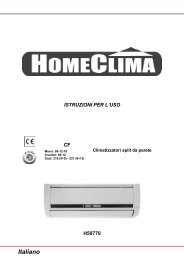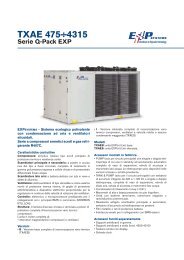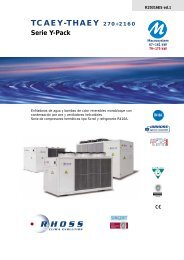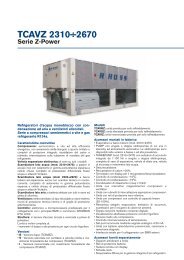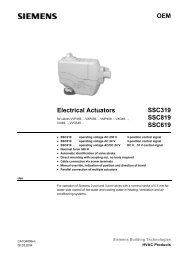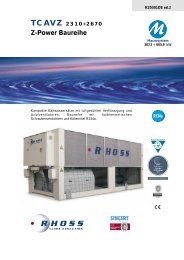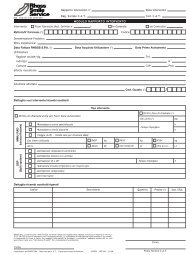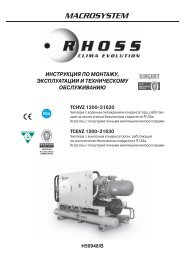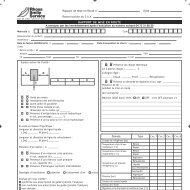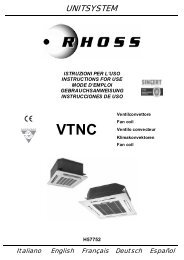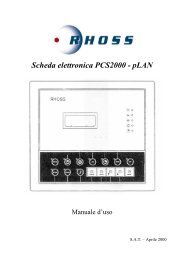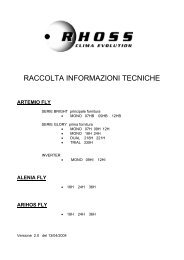SPLIT-SYSTEM - Rhoss
SPLIT-SYSTEM - Rhoss
SPLIT-SYSTEM - Rhoss
Create successful ePaper yourself
Turn your PDF publications into a flip-book with our unique Google optimized e-Paper software.
SECTION II: INSTALLATION AND MAINTENANCE<br />
II.2.6<br />
ELECTRICAL CONNECTIONS<br />
IMPORTANT!<br />
The electrical connections must be made by<br />
specialist personnel in compliance with laws and<br />
regulations in force in the country of installation.<br />
RHOSS shall not be held liable for damage to<br />
persons or property caused by incorrect electrical<br />
connection.<br />
DANGER!<br />
Always install an automatic main switch (IG) in a<br />
protected area near the appliance with a<br />
characteristic delayed curve, with sufficient<br />
capacity and breaking power. There should be a<br />
minimum distance of 3 mm between the contacts.<br />
The automatic main switch (IG) must be placed up<br />
the line from the entire system in order to cut off<br />
the electrical power supply to the main unit and to<br />
all the accessories connected to it which make up<br />
the entire system.<br />
Earth connection is compulsory by law to ensure<br />
user safety while the machine is in use.<br />
Strip off the sheathing only in the immediate area of the terminals. Use<br />
suitable cable-ends for the terminals involved.<br />
After inserting the cable-end into the terminal, tighten the screws with a<br />
screwdriver without applying excessive force: at the end of the<br />
operation, pull gently on the cables to check that they are properly tight.<br />
Use the cable clamp inside the electronic board compartment to lock<br />
the cables.<br />
II.2.6.1<br />
Connecting the power supply<br />
Check that the voltage and the frequency of the electrical supply<br />
correspond to 230V (±10%) single phase at 50 Hz; that the available<br />
power is sufficient for the running the equipment; and that the supply<br />
cables are of adequate section for the maximum current which will be<br />
required.<br />
Make sure that the electrical supply system complies with current<br />
national safety regulations.<br />
When connecting the unit to the electricity network, use flexible bipolar<br />
wiring + earth, 1.5 mm² section with polychloroprene sheath of no<br />
lighter than H05RN-F. The earth conductor must be longer than the<br />
other conductors in order to ensure that in the event of the cable<br />
clamping device becoming slack, it will be the last to come under strain.<br />
The electrical connection wires must be made to pass through conduits<br />
with a sufficient level of protection, which must be firmly secured to the<br />
floor or the walls.<br />
Special attention must be given to any sharp edges, burrs, rough<br />
surfaces in general or threads so as to guarantee that the conductor<br />
insulation is not damaged.<br />
When making connections, removing the internal unit casing and the<br />
external unit side door (refrigerant connections side), insert the electric<br />
wires into the terminals in keeping with the wiring diagrams applied on<br />
the<br />
air conditioning units themselves.<br />
In the event that the unit is mounted on a metal surface, earth<br />
connections must be made in compliance with local regulations.<br />
The connections must be made in compliance with the wiring diagrams<br />
in the enclosed documents.<br />
The electrical line is normally around 2 m longer than the refrigerant<br />
line.<br />
Each internal unit is fitted with a power supply cable with plug.<br />
II.3<br />
START-UP INSTRUCTIONS<br />
IMPORTANT!<br />
Machine commissioning or the first start up (where<br />
required) must be carried out by skilled personnel<br />
qualified to work on this type of product.<br />
DANGER!<br />
Before starting up, make sure that the installation<br />
and electrical connections have been carried out in<br />
accordance with the instructions in this manual.<br />
Also make sure that there are no unauthorised<br />
persons in the vicinity of the machine during the<br />
above operations.<br />
4. the electrical connections are correct;<br />
5. the screws holding the cables are well tightened;<br />
6. the supply voltage is as required;<br />
It is advisable to run the unit at maximum speed for several hours.<br />
II.4<br />
II.4.1<br />
EXTRAORDINARY MAINTENANCE<br />
DANGER!<br />
Maintenance work must only be carried out by<br />
qualified technicians authorised to work on airconditioning<br />
and refrigerant systems.<br />
Use suitable work gloves.<br />
DANGER!<br />
Always turn off the automatic main switch (IG) for<br />
the protection of the entire system before doing any<br />
maintenance work, even if it is only an inspection.<br />
Make sure that no one accidentally supplies power<br />
to the machine – lock the automatic main switch in<br />
the off position.<br />
DANGER!<br />
Beware of the hot surfaces inside the machine.<br />
Do not introduce pointed objects through the air<br />
delivery intake grilles.<br />
REFRIGERANT FLUID CHARGE CONTROL<br />
Fit a pressure gauge on the test point on the outlet side and another on<br />
the test point on the suction side. Start up the unit and check both<br />
pressure readings once the pressure has stabilised.<br />
II.4.2<br />
CHECKING FOR ABSENCE OF<br />
REFRIGERANT FLUID LEAKS<br />
Use a specific leak detector or soapy water to check the refrigerant<br />
circuit and make sure that leaks do not exceed 5 g/year.<br />
II.4.3<br />
CHECKING HEAT EXCHANGER<br />
CLEANLINESS<br />
Switch off the unit, check the heat exchanger and, depending on its<br />
condition, proceed as follows:<br />
• remove any foreign bodies from the finned surface which may<br />
obstruct air flow;<br />
• clean off the dust with a jet of compressed air;<br />
• wash and brush, gently, with water;<br />
• dry with a jet of compressed air;<br />
II.4.4<br />
CHECKING CONDENSATION DRAIN<br />
CLEANLINESS<br />
With the unit switched off, check the cleanliness of the condensation<br />
drain tube.<br />
II.4.5<br />
CHECKING THE ELECTRIC CIRCUIT<br />
The following checks are recommended on the electrical circuit:<br />
• check the unit power absorption using a clip-on meter and compare<br />
the reading with the values shown in Appendix A1;<br />
• inspect and, if necessary, tighten the electrical contacts and<br />
terminals.<br />
II.4.6<br />
COMPONENT REPLACEMENT<br />
INSTRUCTIONS<br />
Before replacing components, discharge coolant from both the high and<br />
low-pressure sides. If the coolant is discharged from the high-pressure<br />
side only, the compressor may close the circuit thereby preventing<br />
pressure equalisation. In this way, the low-pressure side of the casing<br />
and the suction line may remain pressurised. If that happens, if you<br />
apply a brazing torch to one of the low-pressure components of the<br />
system, the pressurised mixture of refrigerant and oil could blow out of<br />
the circuit and ignite on contact with the brazing torch. To avoid this<br />
hazard, make sure both the high and low pressure sides of the circuit<br />
have been correctly depressurised before applying brazing torches.<br />
Any topping up of the system on units with R410A refrigerant must be<br />
carried out in the liquid phase, piping it from a cylinder so as not to alter<br />
its composition.<br />
II.3.1<br />
CONTROLS BEFORE START-UP<br />
Before starting up the unit, make sure that:<br />
1. the unit is positioned correctly;<br />
2. the system flow, return and condensation drainage pipes are<br />
correctly connected;<br />
3. the exchanger is clean;<br />
34



